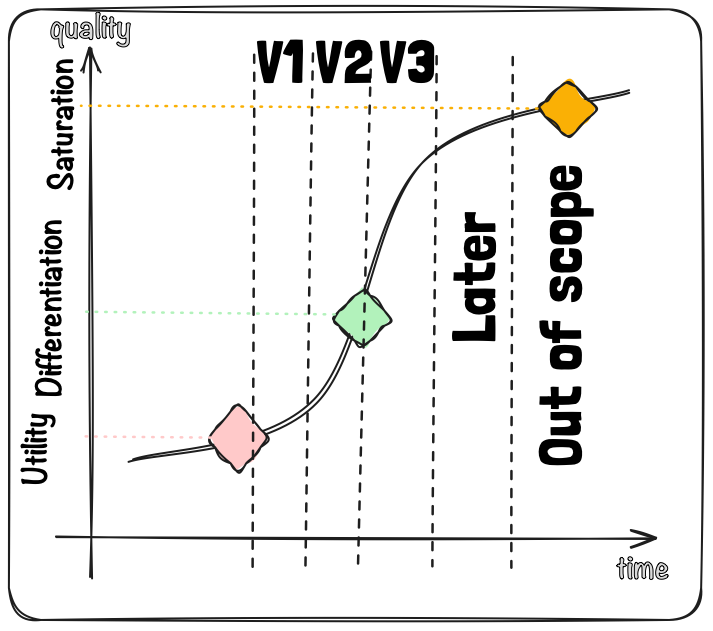QUPER model
QUPER (QUality PERformance) model is a method for defining release plans and targets for cross-functional, system-wide quality aspects of a system (such as usability, performance, scalability and similar…). It aids with prioritisation and roadmap planning.
The model was developed by Bjorn Regnell and Richard Berntsson Svensson at Lund University in Sweden as a way to “align the debate about what quality should delivery”.
The QUPER model presumes that cross-functional system attributes evolve over a cost/value curve, with a continuous scale rather than using discrete steps. For example, system performance can improve or deteriorate, instead of just existing or not existing in as in a discrete binary way. The model requires identifying three “breakpoints” on the value curve for each cross-functional aspect:
- Utility - the point below which the solution does not apply to the current market
- Differentiation - the point above which the solution is significantly better than the competition
- Saturation - the point above which the market would not be ready for further improvements
The three breakpoints depend on the competing solutions or customer expectations, not on the opinions of the stakeholders. (Look for them in market research or in competitor analysis, do not ask individual stakeholders for their opinion).

Once market expectations are established, define a release plan by engaging stakeholders in a discussion about where on each of these curves the solution needs to be in which release or product version.
- Parity aspects (those that just need to be good enough) most likely fall between the utility and differentiation point.
- Unique selling points most likely fall between differentiation and saturation points
- Nothing should be above its saturation point
You can use the Purpose Alignment Model to assist in this kind of decision making.
As the market opportunities change, so do customer expectations, and the utility/differentiation/saturation points in the future might not be the same as in the present (today’s exciters become tomorrow’s expected levels of performance). Review the market situation regularly when working with the QUPER model, and adjust the plans accordingly.
The key value of this model is to present options and thresholds in an objective way, and facilitate a discussion about how much should be invested in different aspects of a solution, and when. You can define segments of acceptable performance for each release, agreeing how your product will evolve over time.
Learn more about the QUPER model
- The QUPER Model for software quality requirements roadmapping, video from the Oredev conference presentation by Björn Regnell (2009)
- A Case Study Evaluation of the Guideline-Supported QUPER Model for Elicitation of Quality Requirements, from Requirements Engineering: Foundation for Software Quality/Lecture Notes in Computer Science, ISBN 978-3-319-16100-6 by Richard Berntsson Svensson, Björn Regnell (2015)
- Fifty Quick Ideas To Improve Your User Stories, ISBN 978-0993088100, by Gojko Adzic, David Evans